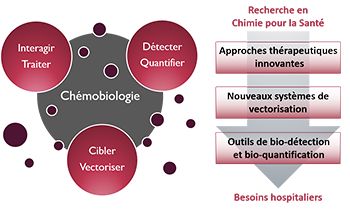- ⌂
-
Le DPM
Les Equipements
L'Environnement
Zoom sur... Le Bâtiment André Rassat
Nommé d'après une figure tutélaire de la chimie grenobloise, ce bâtiment est recouvert d’une double peau en feuille métallique qui apporte une protection thermique sur 3 côtés et crée une unité architecturale favorisant l'intégration parmi les arbres du site.
-
Thématiques
Le Thème
« Approches thérapeutiques innovantes »De nouvelles solutions thérapeutiques, de la cible biomacromolécu-laire émergente aux approches originales pour traiter les maladies
Le Thème
« Nouveaux systèmes de vectorisation »Combiner les propriétés d’inclusion de principes actifs, de franchisse-ment de barrières, d’adressage et de relar-gage en milieu vivant
Le Thème
« Outils de bio-détection et bio-quantification »Des dispositifs analytiques originaux pour la détection de cibles, de l’ion au micro-organisme en milieu complexe
Zoom sur... La Chémobiologie

-
Équipes
L'Équipe « COMET »
« COMET » développe la conception rationnelle, la synthèse et/ou l'extraction de composés à forte diversité/complexité comme nouveaux agents thérapeutiques et outils moléculaires pour la pénétration cellulaire ou la détection de biomolécules, actifs in vivo.L'Équipe « NOVA »
« NOVA » utilise des acides nucléiques fonctionnels comme éléments de reconnaissance pour des applications thérapeutiques ou diagnostiques, comme la sélection d'oligonucléotides, ou le développement de dispositifs d'analyses et de nanovecteurs.Les Services
-
Productions
Les Publications
La Vulgarisation
Les JSM
Zoom sur... La 12ème JSM (15 juin 2023)
Le DPM organise des journées scientifiques consacrées au médicament. L'objectif est de rassembler les spécialistes académiques et industriels autour d'une thématique. 2023 : Apports de la Chimie Click et de la Lumière en Chemobiologie
-
Partenariats
Les Formations
Les Consortiums
Les Financements
Zoom sur... L'environnement Grenoblois
Le DPM est un acteur central sur le bassin grenoblois en chimie, biologie et santé, lié au CHU Grenoble Alpes et à de nombreuses autres organisations : Pole de Recherche CBS, ICMG, Labex ARCANE, EUR CBH, Institut Carnot Polynat, Réseau GREEN.
Article
- Projet
- Marine PEUCHMAUR,
- Titre
- Ovarian cancer cells cisplatin sensitization agents selected by mass cytometry target ABCC2 inhibition
-
[Full paper
 ]
] - Auteurs
- E. Comsa, K.-A. Nguyen, F. Loghin, A. Boumendjel, M. Peuchmaur, T. Andrieu, P. Falson.
- Edition
- Future Med. Chem. 2018, 10, 11, 1349-1360
- Année
- 2018
- Résumé
- Overcoming cisplatin resistance in ovarian cancer remains a spiny problem as tumors frequently develop resistance against drugs, a mechanism in which ATP-binding cassette (ABC) transporters received attention because of their role in drugs bioavailability and toxicity. Previous studies left the spotlight on ABCC2, an apical efflux pump highly expressed in intense metabolic organs and barriers, displaying an overexpression in certain cisplatin-resistant cancers. Our goal was to find compounds restricting their inhibition capacity to the cisplatin efflux mediated by the pump, without altering its important physiological and metabolic role. We evaluated a series of furanones we recently identified as inhibitors of ABCC2-mediated calcein efflux on cisplatin accumulation in resistant ovarian cancer cells. To quantify cisplatin accumulation, we set up an original method allowing direct quantitation of platinum (Pt) by employing cyTOF mass cytometry. We observed a wide range of efficacies of the series on cisplatin efflux inhibition but strikingly, not correlated with that of calcein, suggesting distinct efflux mechanisms mediated by ABCC2. Among these furanones derivatives, some led to a full Pt accumulation and efficiently re-sensitized cisplatin-resistant A2780 cells to cisplatin toxicity while preserving most of the calcein efflux activity. CyTOF is therefore a powerful and promising method to quantify cisplatin accumulation that may be used in the clinical setting to improve and personalize cancer treatment.




 Annuaire
Annuaire Contact
Contact Plan d'accès
Plan d'accès ENG
ENG Login
Login



